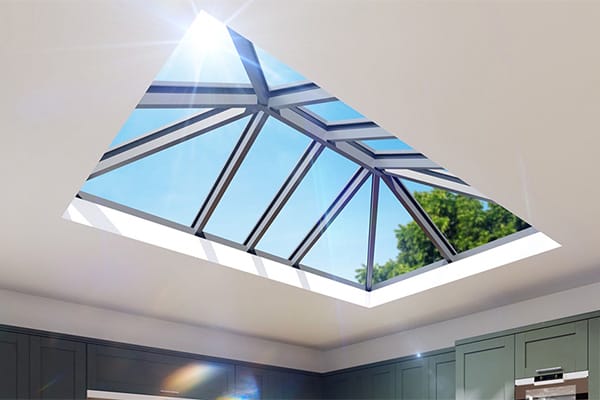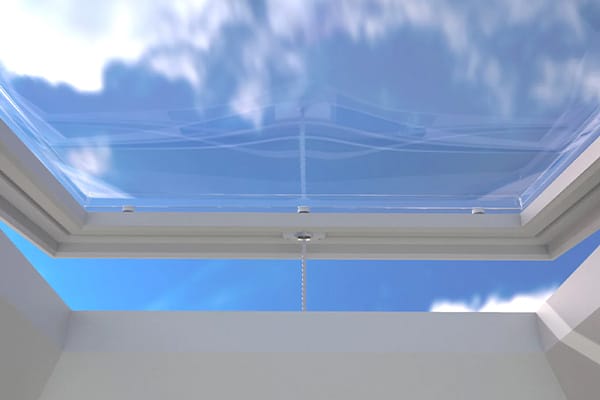Best Rooflights for Small Spaces: Brighten Your Home
For interior designers, architects, and apartment/homeowners who want maximum light and minimum clutter. This guide highlights the best rooflight options, their benefits, and the key considerations for making compact rooms feel bigger, brighter, and more liveable.
Why Rooflights Are Perfect for Small Space?
Small rooms have two universal problems: little wall area and not enough daylight. Rooflights solve both because they bring light from above, not from the side. That one change has an outsized impact:
- Deeper daylight penetration. Light falling from the roof plane reaches further into the floor area than a similar-sized vertical window. In narrow rooms and corridors, that can mean useful light where a standard window would barely register.
- No loss of wall space. Storage, radiators, tall cabinets, artwork keep them all. Rooflights don’t compete for the same wall real estate that compact rooms need for function.
- Visual height. A clear slice of sky immediately makes ceilings feel taller, which reduces the “boxed-in” sensation typical of small bedrooms, home offices, and studios.
- Privacy with brightness. On overlooked plots or ground floors, small space rooflights deliver abundant daylight without inviting street or neighbour views into the room.
- Design flexibility. Flush, frameless styles suit modern interiors; conservation looks keep planners happy in heritage contexts. Either way, you get daylight without visual bulk.
If you’re evaluating the Best Rooflights for Small Spaces, think about where you actually need the light to land. Over a kitchen island, across a desk, onto a reading nook placing the opening above the activity zone often outperforms a larger but poorly positioned window. As a rule of thumb, many compact rooms come alive when the glazed area is around 15–20% of the floor area (split across two smaller rooflights if the plan is long). You’ll get more even illumination, less glare, and better control of shadows.
Best Rooflight Options for Small Spaces

Below are the rooflight types that repeatedly deliver in tight floor plans. Mix and match to suit roof build-up (flat or pitched), ventilation needs, and the interior layout.
- What they do best: deliver the cleanest, most minimal “slice of sky” with slim or frameless sight-lines.
- Where they shine: above kitchen islands, dining zones, shower enclosures (with the right glazing and ventilation), and corridor pinch-points that feel dark.
- Why they’re small-space friendly: no sash or hardware intruding into head height; visually very calm.
2) Opening flat rooflights (manual or electric)
- What they do best: combine daylight with purge ventilation hugely useful in compact kitchens and bathrooms.
- Smart extras: rain sensors, thermostatic or humidity triggers, and integration with home-automation to pre-ventilate before you get home.
- Small-space tip: two smaller openers (one near the heat/moisture source, one further away) can out-perform a single big unit.
3) Pitched roof windows (centre-pivot / top-hung)
- What they do best: rapid ventilation and excellent sky + horizon views when seated.
- Where they shine: loft bedrooms, attic studies, and tiny ensuites under rafters.
- Small-space tip: top-hung windows open out and away, which preserves internal headroom over desks and dressing tables.
- What they do best: deliver long ribbons of light across slender spaces without cutting big structural holes.
- Where they shine: galley kitchens and hallway “light spines”.
- Small-space tip: stagger modules to avoid a single hard beam of light; your space will feel softer and more uniformly bright.
- What they do best: bring daylight to a room below while giving you usable outdoor floor area above perfect when plot size is limited.
- Where they shine: basements, ground-floor middle rooms in terrace houses, and light-hungry stairwells.
- Safety note: specify laminated, anti-slip glass with the correct load rating.
6) Conservation-style rooflights
- What they do best: respect heritage rooflines while still pouring light into tight lofts.
- Where they shine: period properties and planning-sensitive streetscapes.
- Small-space tip: choose low-iron glass to keep the small aperture looking crystal clear, not green-tinted.
Considerations When Choosing Rooflights for Small Spaces
A great small-space scheme balances light quality, thermal comfort, and practical constraints. Use this checklist to get it right first time.

Daylight & solar control
- Orientation matters: South and west pitches catch stronger sun; choose a solar-control coating (g-value around 0.35–0.45) and consider blinds to prevent summer hot spots in compact rooms.
- Spread the light: Two mid-sized rooflights generally give smoother illumination than one large pane. That’s especially true in long, narrow rooms.
Thermal performance & comfort
- U-value targets: Aim for whole-window U-values at or below 1.2 W/m²K for refurbishments and closer to 1.0 W/m²K for new builds if you’re chasing high efficiency.
- Warm-edge spacers & argon: These reduce condensation at edges useful in small rooms where surfaces are closer to occupants.
- Glazing build-up: For bedrooms and studies, laminated inner panes can add acoustic calm.
Ventilation & indoor air quality
- Opening vs fixed: In a tiny kitchen or bathroom, opening rooflights can clear moisture in minutes and protect finishes.
- Automation: Humidity-triggered opening strikes a perfect balance in compact spaces that steam up quickly.
Structure, access & installation
- Build-up dictation: Flat roofs typically need a thermally insulated upstand; pitched roofs rely on compatible flashing kits (tile/slate/metal).
- Access planning: Even small panes can be heavy; ensure installers can lift safely or use mini-cranes if needed. In tight urban plots, agree delivery and lifting routes early.
- Services clashes: In compact lofts, carefully plot rafters, electrics, MVHR ducts and joists to avoid compromises on rooflight position.
Privacy, overlooking & safety
- Views in vs views out: Frosted or patterned glass protects privacy while still delivering useful daylight.
- Overhead safety: Use laminated inner panes for any overhead glass; in walk-on applications, specify the correct live-load rating and anti-slip finish.
Planning & compliance
- Permitted development: Many rooflights are PD if they sit close to the roof plane; always check local rules especially in conservation areas and on flats/maisonettes.
- Escape requirements: In loft bedrooms, ensure at least one opening meets emergency egress criteria (size, clear opening, sill height).
Also read: What is the difference between a skylight, rooflight or roof window?
Maintenance and Care for Rooflights in Small Spaces

Small rooms magnify small problems. A simple, proactive care plan keeps your rooflights performing and looking their best.
Glass & finishes
- Easy-clean coatings: These help rain wash away dirt particularly useful where external access is awkward.
- Cleaning routine: For fixed units, use a magnetic squeegee system or a telescopic pole; for pitched windows, select models with an easy-clean flip to reach the outer pane safely.
- Mind the frame: Wipe aluminium with pH-neutral cleaner; avoid abrasive pads that can dull powder-coat finishes.
Seals, drainage & condensation
- Perimeter checks: Inspect sealant joints annually; UV and building movement can stress edges.
- Kerb drainage: Keep channels and weep holes clear so water can escape especially vital on flat roofs.
- Condensation control: Combine good ventilation, warm-edge spacers, and correct humidity levels. In bathrooms, link roof light opening to the extractor or humidity sensor.
Blinds & automation
- Blinds: Thermal or blackout blinds add comfort in sleeping areas; keep tracks dust-free so they run smoothly.
- Sensors & remotes: Test rain sensors monthly; replace batteries annually. Update smart-home firmware so schedules run reliably.
A few minutes of care prevents the kind of issues that feel “bigger” in compact rooms streaks, fogging, or sticky blinds.
Conclusion
Small rooms don’t need large windows; they need well-placed rooflights that deliver focused daylight, clever ventilation, and a visually calm ceiling. Among the Best Rooflights for Small Spaces, the winning recipe usually looks like this:
1. A fixed or opening flat rooflight precisely over the task zone (island/desk/sofa).
2. A second, smaller unit to balance light in long rooms or a pitched roof window in lofts for easy purge ventilation.
3. High-performance glazing with low-E, warm-edge spacers, and (where helpful) an acoustic or privacy laminate.
4. Planned access and detailing so the installation is airtight, watertight, and maintenance-friendly.
Do that, and even the tightest plan reads as bright, open, and inviting without surrendering storage, privacy, or thermal comfort. That’s the power of small space rooflights used intelligently.
Ready to specify?
SM Glasstech makes small-space rooflights simple. Share a sketch, rough sizes, or photos and we’ll turn it into a build-ready plan.






